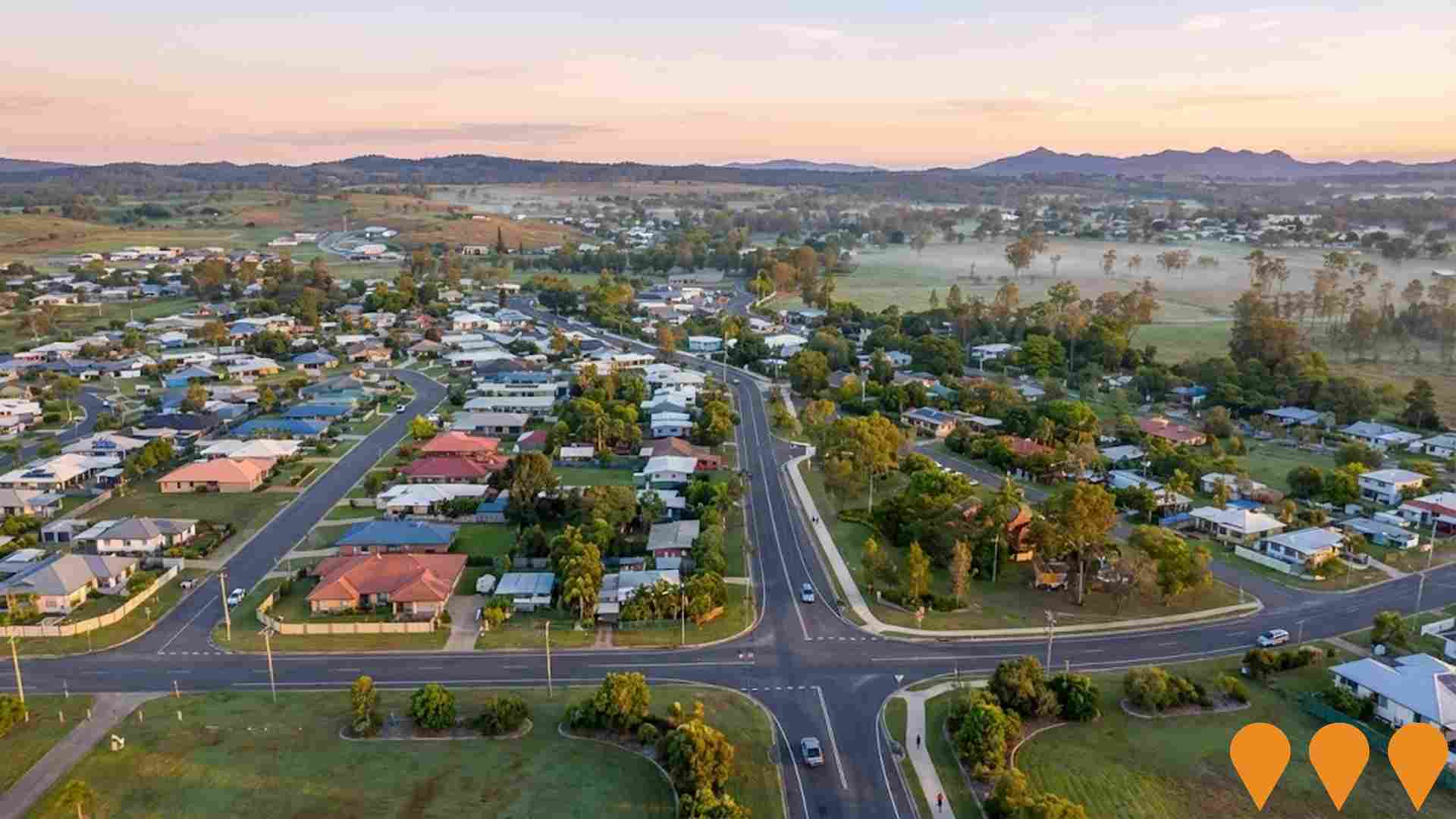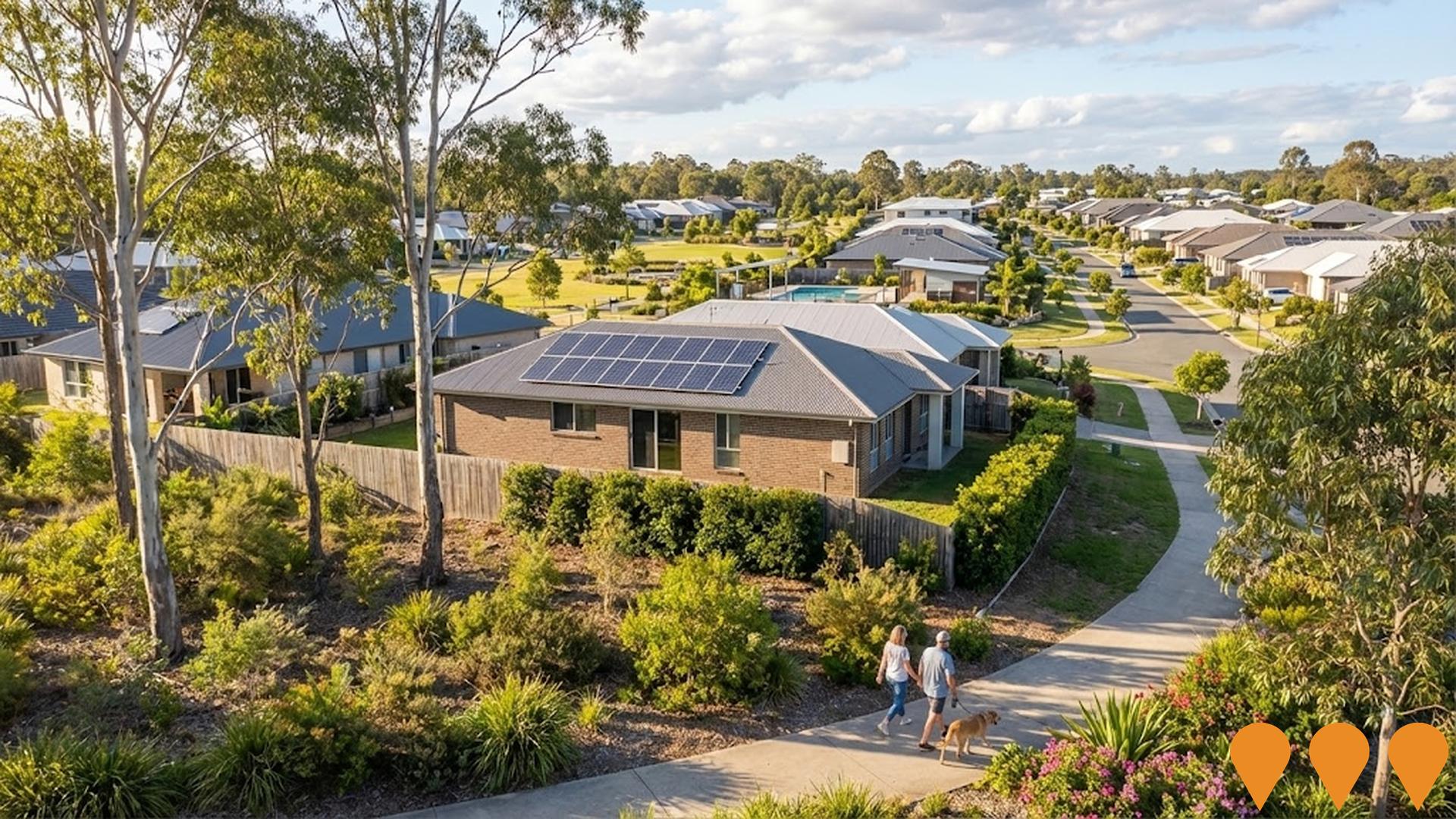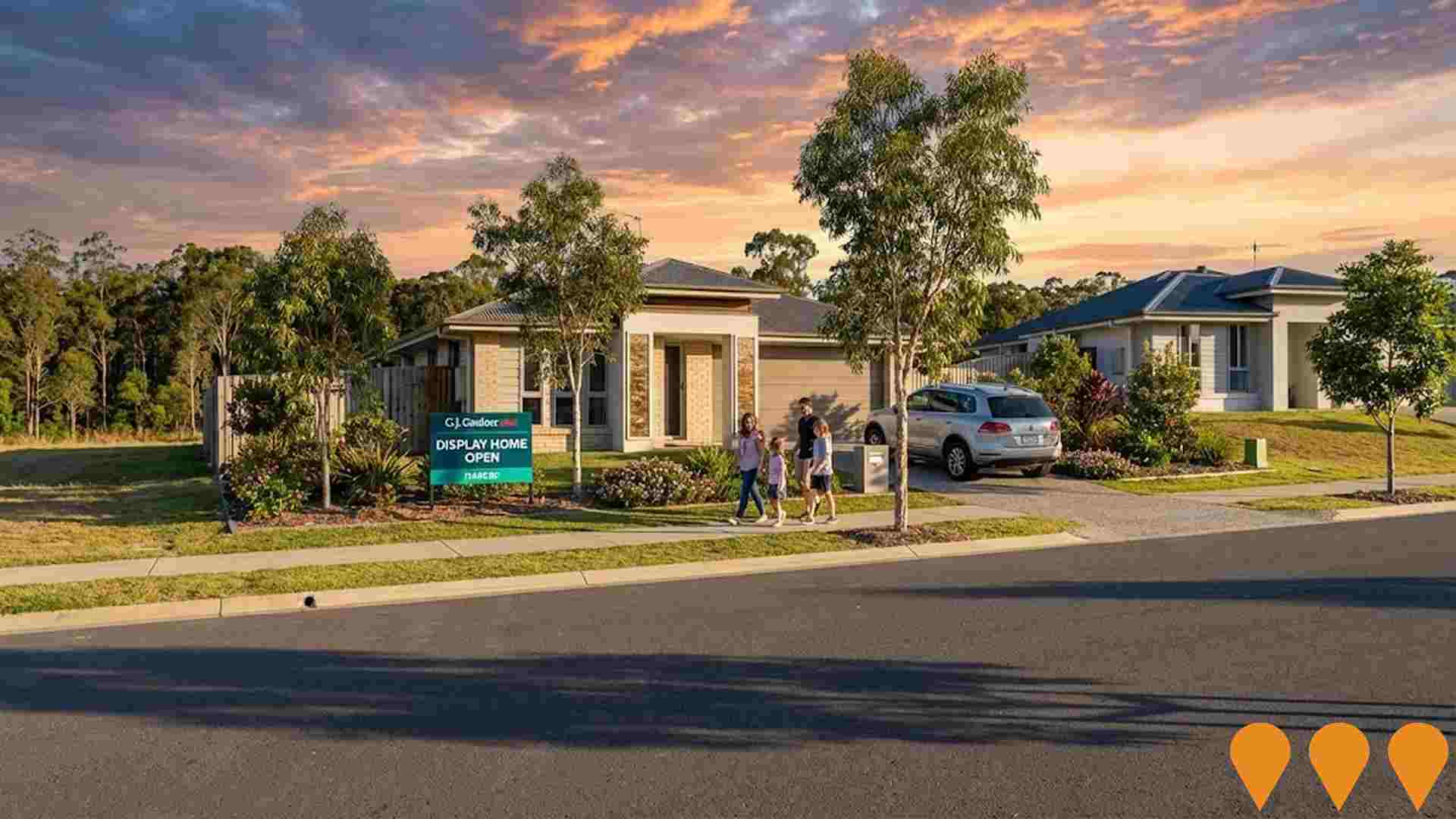Chart Color Schemes
est. as @ -- *
ABS ERP | -- people | --
2021 Census | -- people
Sales Activity
Curious about local property values? Filter the chart to assess the volume and appreciation (including resales) trends and regional comparisons, or scroll to the map below view this information at an individual property level.
Find a Recent Sale
Sales Detail
Population
An assessment of population growth drivers in Gladstone reveals an overall ranking slightly below national averages considering recent, and medium term trends
Based on AreaSearch's analysis, Gladstone's population was around 6733 as of November 2025. This reflected an increase of 559 people, representing a 9.1% growth since the 2021 Census which reported a population of 6174 people. The change was inferred from the estimated resident population of 6709 from the ABS as of June 2024 and an additional 21 validated new addresses since the Census date. This level of population equated to a density ratio of 658 persons per square kilometer, indicating significant space per person and potential room for further development. Gladstone's growth of 9.1% since the 2021 census exceeded that of the SA4 region (6.6%) and the SA3 area, marking it as a growth leader in the region. Population growth was primarily driven by overseas migration contributing approximately 61.3% of overall population gains during recent periods, although all drivers including natural growth and interstate migration were positive factors.
AreaSearch adopted ABS/Geoscience Australia projections for each SA2 area, released in 2024 with a base year of 2022. For areas not covered by this data and years post-2032, Queensland State Government's SA2 area projections released in 2023 based on 2021 data were adopted. Considering projected demographic shifts, an above median population growth for Australian non-metropolitan areas was projected, with the area expected to grow by 932 persons to 2041 based on the latest population numbers, indicating a total increase of 13.5% over the 17 years.
Frequently Asked Questions - Population
Development
Residential development activity is lower than average in Gladstone according to AreaSearch's national comparison of local real estate markets
Gladstone averaged approximately five new dwelling approvals annually over the past five financial years, totalling 25 homes. As of FY-26, three approvals have been recorded. On average, 21.6 people moved to the area per year for each dwelling built between FY-21 and FY-25, indicating supply lagging demand. New properties are constructed at an average expected cost of $372,000.
In FY-26, there have been $16.2 million in commercial approvals, showing steady commercial investment activity. Compared to the Rest of Qld, Gladstone has significantly less development activity, 76.0% below the regional average per person. This constrained new construction typically reinforces demand and pricing for existing dwellings, although recent periods have seen increased activity. Nationally, development activity is also below average, suggesting possible planning constraints. New development consists of 40.0% detached houses and 60.0% medium and high-density housing, marking a shift from the current pattern of 58.0% houses. This focus on higher-density living creates more affordable entry points for downsizers, investors, and first-home buyers, potentially due to diminishing developable land availability and evolving lifestyle preferences. The estimated population count per dwelling approval is 3482 people, reflecting Gladstone's quiet development environment.
Population forecasts indicate the area will gain 908 residents by 2041. If current construction levels persist, housing supply may lag population growth, potentially intensifying buyer competition and underpinning price growth.
Frequently Asked Questions - Development
Infrastructure
Gladstone has emerging levels of nearby infrastructure activity, ranking in the 33rdth percentile nationally
Changes to local infrastructure significantly impact an area's performance. AreaSearch identified eleven projects likely to affect the region. Notable ones are HPA First Project Stage 2, Hughes Road Battery Energy Storage System (BESS), Port of Gladstone Gatcombe and Golding Cutting Channel Duplication Project, and Gladstone Project. The following list details those most relevant.
Professional plan users can use the search below to filter and access additional projects.
INFRASTRUCTURE SEARCH
 Denotes AI-based impression for illustrative purposes only, not to be taken as definitive under any circumstances. Please follow links and conduct other investigations from the project's source for actual imagery. Developers and project owners wishing us to use original imagery please Contact Us and we will do so.
Denotes AI-based impression for illustrative purposes only, not to be taken as definitive under any circumstances. Please follow links and conduct other investigations from the project's source for actual imagery. Developers and project owners wishing us to use original imagery please Contact Us and we will do so.
Frequently Asked Questions - Infrastructure
HPA First Project Stage 2
The HPA First Project is a high-purity alumina refinery in the Gladstone State Development Area. Stage 1 is in production. Stage 2, which is under construction, will be the world's largest single-site facility for high-purity aluminium materials, capable of producing 10,000 tonnes per annum of HPA equivalent using proprietary Smart SX Technology for use in LEDs, semiconductors, and lithium-ion batteries. First production for Stage 2 is targeted for late 2026.
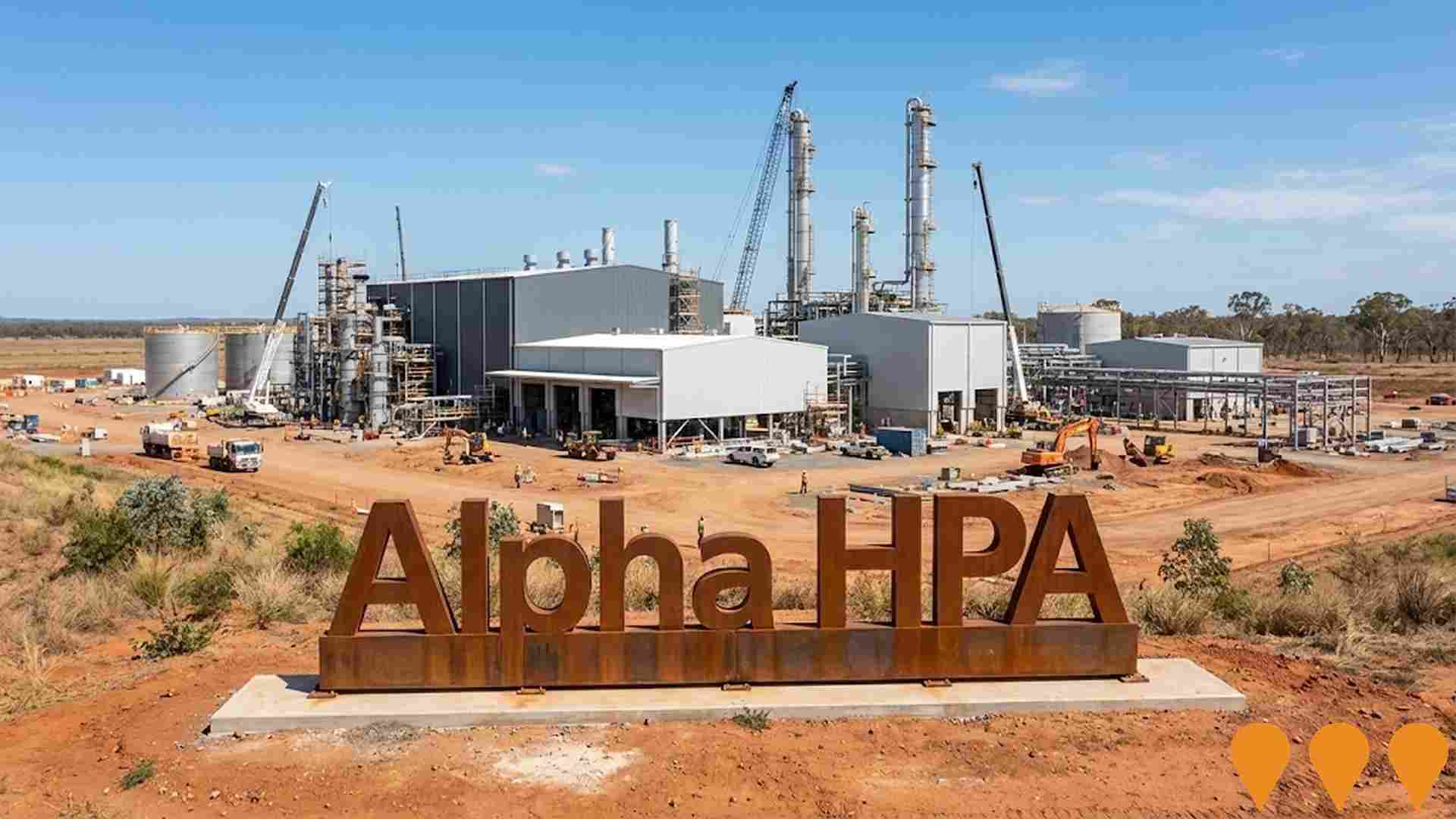
Wiggins Island Coal Export Terminal (WICET)
Privately funded coal export terminal at Golding Point within the Port of Gladstone. Stage 1 delivers 27 Mtpa capacity via rail receival, a 5.6 km covered overland conveyor to stockyards, and an offshore wharf ~2 km from shore with a single berth and shiploader. Terminal aligns with Queensland Ports Strategy and can expand on the existing site when demand supports it. Owned by Wiggins Island Coal Export Terminal Pty Ltd (industry consortium).

Harvey Road Sports and Events Precinct
Comprehensive redevelopment of Harvey Road sports facilities including Marley Brown Oval, junior rugby league fields, and touch football fields to create a year-round, multi-purpose precinct with broadcasting capabilities. The upgraded precinct will accommodate up to 10,000 spectators and be suitable for national, state and regional games, carnivals and large outdoor events, while continuing to support grassroots local and regional sports participation and daily community use. The project enhances Central Queensland's rugby league heartland status and provides a large outdoor event venue for the Gladstone Region.

Hughes Road Battery Energy Storage System (BESS)
A proposed 200MW/800MWh lithium-ion battery energy storage system designed to enhance grid stability and support renewable energy integration in the Central Queensland Renewable Energy Zone. The project is located near the existing Wurdong Substation and is currently undergoing the planning and environmental assessment process. Construction is tentatively scheduled to begin in late 2025, with operations expected to commence in 2027.
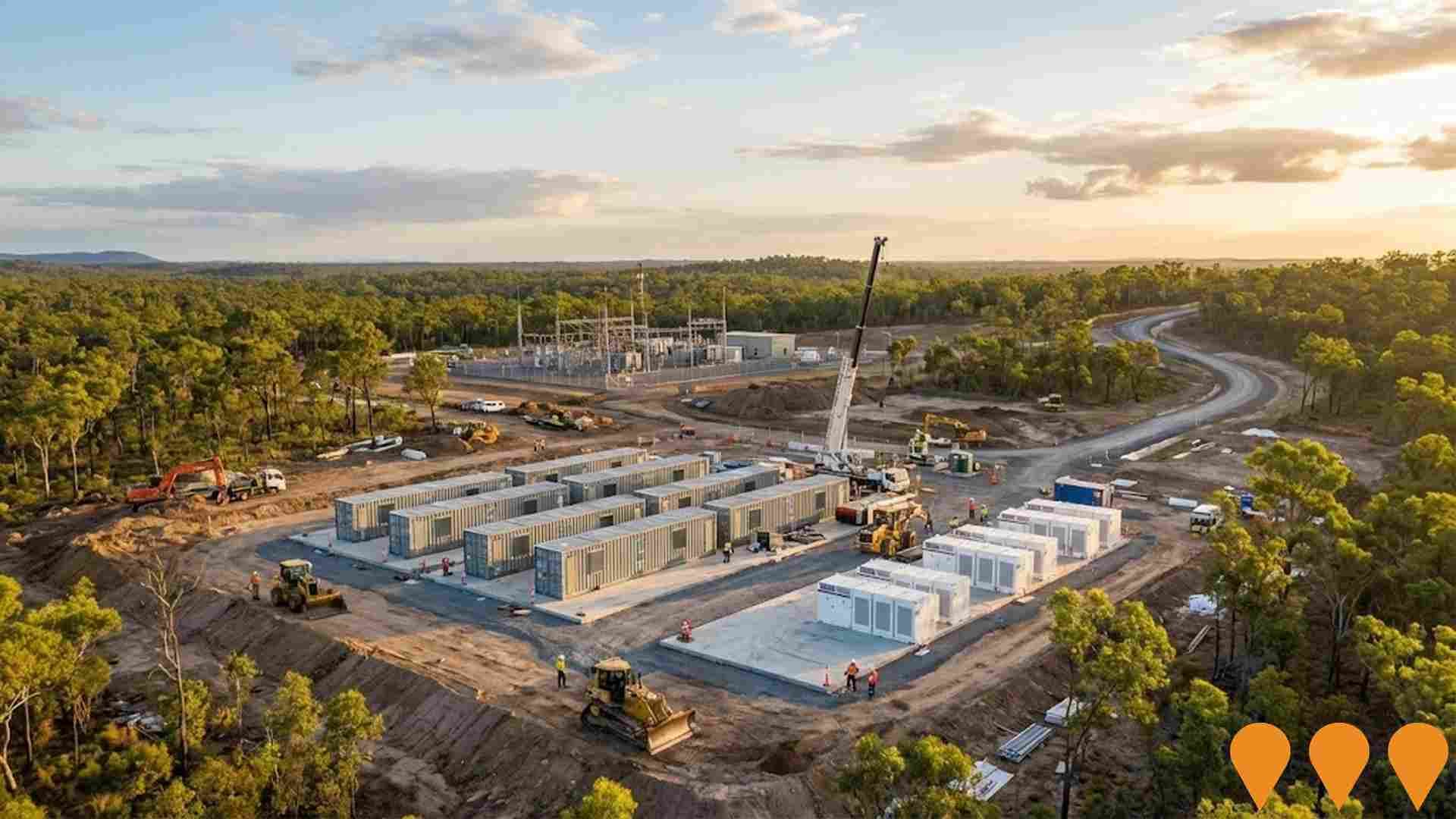
Port of Gladstone Gatcombe and Golding Cutting Channel Duplication Project
The project involves duplicating the Gatcombe and Golding Cutting channels in the Port of Gladstone outer harbour by deepening and widening existing channels to a depth of 16.1 meters and width of 200 meters over approximately 15 kilometers to enable safe two-way passage for larger ships under all weather and tidal conditions, increasing cargo throughput and including dredged material placement in reclamation areas and navigational aid relocation.
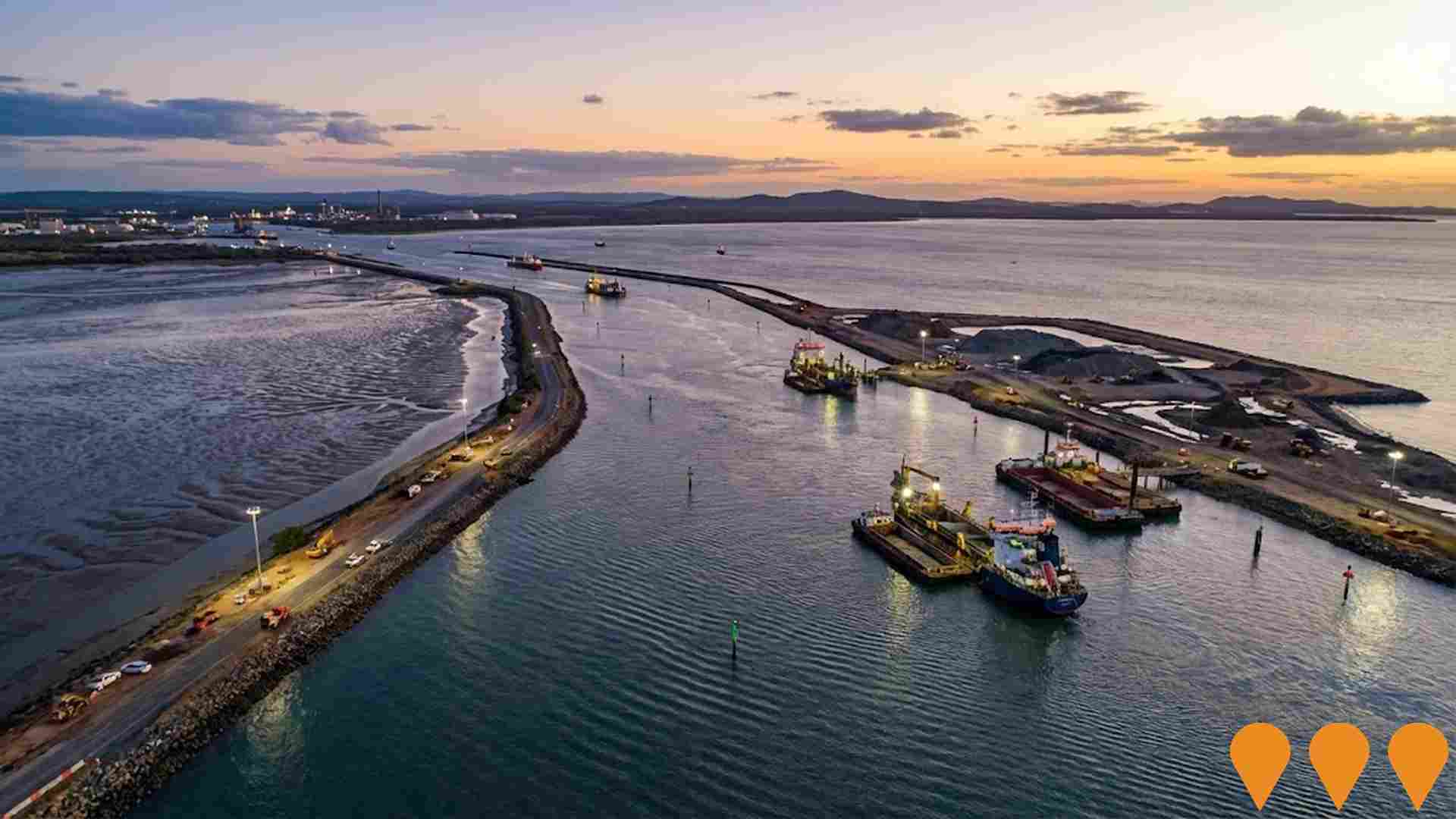
Gladstone Project
Powerlink Queensland's Gladstone Project (also known as the Gladstone grid reinforcement) is a multi-stage transmission network reinforcement to maintain reliability and security of electricity supply in the Gladstone region following the anticipated retirement of Gladstone Power Station. It supports industrial decarbonisation, electrification of major industries, and integration of renewables from the Central Queensland REZ. Key stages include new 275kV double-circuit lines (Calvale-Calliope River and Bouldercombe-Larcom Creek via new Gladstone West Substation), synchronous condensers, and reactive support equipment. Final Assessment Report submitted June 2025; government review ongoing with construction of Stage 1 expected mid-2026.

Clinton Vessel Interaction Project
The Clinton Vessel Interaction Project widened the Clinton Channel by about 100m to reduce vessel interaction risks such as mooring breaks or collisions, involving the dredging of approximately 800,000m3 of material to enhance safe navigation for outbound vessels in the Port of Gladstone.
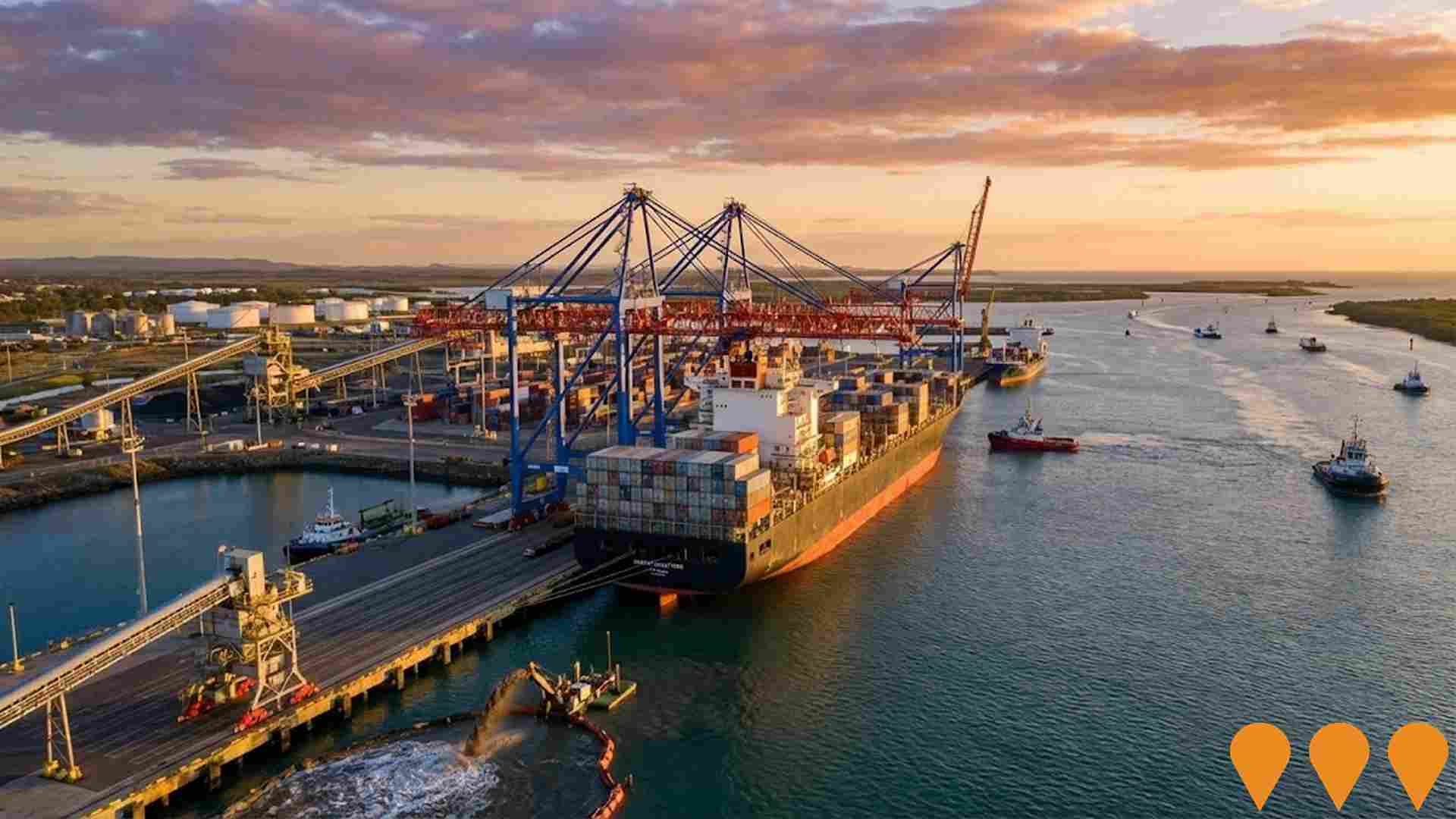
Gladstone Energy and Ammonia Project
A coal gasification facility designed to produce 230,000 tonnes per annum of ammonia, 14 petajoules per annum of synthetic natural gas, and up to 96 megawatts of electrical power. The project involves converting 1.5 million tonnes per annum of coal to manufacture clean hydrogen via ammonia synthesis, with carbon dioxide capture for utilization and sequestration. Located on a 129-hectare site in the Gladstone State Development Area with access to gas pipelines, water, power and rail infrastructure. The coordinated project declaration lapsed on 30 April 2022 and the project is currently on hold pending renewed approvals.

Employment
The labour market performance in Gladstone lags significantly behind most other regions nationally
Gladstone's workforce is skilled with strong manufacturing and industrial sectors. The unemployment rate was 14.7% in the past year, showing estimated employment growth of 2.2%.
As of June 2025, 3,190 residents were employed while the unemployment rate stood at 10.7%, above Rest of Qld's rate of 3.9%. Workforce participation was 57.1%, below Rest of Qld's 59.1%. Leading employment industries included manufacturing, health care & social assistance, and accommodation & food services. Manufacturing had notable concentration with employment levels at 2.1 times the regional average.
Health care & social assistance had limited presence with 11.6% employment compared to 16.1% regionally. The area hosted more jobs than residents, with 1.2 workers per resident as of the Census. Over a 12-month period ending in June 2025, employment increased by 2.2%, labour force grew by 4.8%, and unemployment rose by 2.2 percentage points. In contrast, Rest of Qld saw employment rise by 1.8%, labour force grow by 2.0%, and unemployment rise by 0.2 percentage points. National employment forecasts from Jobs and Skills Australia, issued in May 2025, projected national growth of 6.6% over five years and 13.7% over ten years. Applying these projections to Gladstone's employment mix suggested local growth of approximately 5.6% over five years and 12.2% over ten years.
Frequently Asked Questions - Employment
Income
Income levels sit below national averages according to AreaSearch assessment
Gladstone's median income among taxpayers was $51,402 in financial year 2022. The average income stood at $63,540 during the same period. This compares to figures for Rest of Qld's of $50,780 and $64,844 respectively. According to Wage Price Index growth of 13.99% since financial year 2022, current estimates would be approximately $58,593 (median) and $72,429 (average) as of September 2025. Census 2021 income data shows household, family and personal incomes in Gladstone all fall between the 15th and 26th percentiles nationally. The predominant income cohort spans 26.0% of locals (1,750 people) with incomes ranging from $1,500 to 2,999, reflecting patterns seen in the broader area where 31.7% similarly occupy this range. Housing affordability pressures are severe, with only 83.6% of income remaining after housing costs, ranking at the 15th percentile.
Frequently Asked Questions - Income
Housing
Gladstone displays a diverse mix of dwelling types, with a higher proportion of rental properties than the broader region
Gladstone's dwelling structure, as per the latest Census, consisted of 58.0% houses and 42.1% other dwellings (semi-detached, apartments, 'other' dwellings), contrasting with Non-Metro Qld's 85.7% houses and 14.3% other dwellings. Home ownership in Gladstone stood at 22.0%, with mortgaged dwellings at 23.0% and rented ones at 55.1%. The median monthly mortgage repayment was $1,394, below Non-Metro Qld's average of $1,600. Median weekly rent in Gladstone was $230, compared to Non-Metro Qld's $275. Nationally, Gladstone's mortgage repayments were significantly lower than the Australian average of $1,863, while rents were substantially below the national figure of $375.
Frequently Asked Questions - Housing
Household Composition
Gladstone features high concentrations of lone person households and group households, with a lower-than-average median household size
Family households compose 52.8% of all households, including 18.2% couples with children, 21.0% couples without children, and 12.1% single parent families. Non-family households account for the remaining 47.2%, with lone person households at 42.7% and group households comprising 4.7%. The median household size is 2.0 people, smaller than the Rest of Qld average of 2.5.
Frequently Asked Questions - Households
Local Schools & Education
Educational outcomes in Gladstone fall within the lower quartile nationally, indicating opportunities for improvement in qualification attainment
The area's university qualification rate is 18.4%, substantially lower than Australia's average of 30.4%. This presents both a challenge and an opportunity for targeted educational initiatives. Bachelor degrees are the most common at 13.5%, followed by postgraduate qualifications (3.2%) and graduate diplomas (1.7%). Vocational credentials are prominent, with 41.4% of residents aged 15+ holding them - advanced diplomas at 7.4% and certificates at 34.0%.
Educational participation is high, with 28.2% currently enrolled in formal education: 10.0% in primary, 8.8% in secondary, and 3.2% in tertiary education. Gladstone's four schools have a combined enrollment of 2,329 students, operating under typical Australian school conditions (ICSEA: 971) with balanced educational opportunities. The area functions as an education hub with 34.6 school places per 100 residents - significantly higher than the regional average of 18.2 - attracting students from surrounding communities.
Frequently Asked Questions - Education
Schools Detail
Nearby Services & Amenities
Transport
Transport servicing is low compared to other areas nationally based on assessment of service frequency, route connectivity and accessibility
Gladstone's public transport analysis indicates 30 active stops operating within the city, all of which are bus stops. These stops are served by three individual routes that collectively facilitate 105 weekly passenger trips. The accessibility of transport in Gladstone is rated as good, with residents typically located 247 meters from their nearest transport stop.
On average, service frequency across all routes amounts to 15 trips per day, equating to approximately 3 weekly trips per individual stop.
Frequently Asked Questions - Transport
Transport Stops Detail
Health
Health performance in Gladstone is well below average with prevalence of common health conditions notable across both younger and older age cohorts
Gladstone faces significant health challenges, with common conditions prevalent among both younger and older age groups. Private health cover stands at approximately 51% (~3,447 people), slightly lower than the average SA2 area's 55.6%.
Mental health issues affect 11.3%, while arthritis impacts 8.7% of residents. Conversely, 64.1% report no medical ailments, compared to 69.4% in Rest of Qld. The area has a higher proportion of older residents (aged 65 and over), at 15.2% (1,022 people).
Frequently Asked Questions - Health
Cultural Diversity
In terms of cultural diversity, Gladstone records figures broadly comparable to the national average, as found in AreaSearch's assessment of a number of language and cultural background related metrics
Gladstone's cultural diversity aligns with its wider region, with 81.6% of residents being citizens, 80.7% born in Australia, and 89.5% speaking English only at home. Christianity is the predominant religion, practiced by 46.2%. Hinduism shows overrepresentation, comprising 1.7%, compared to the region's 0.7%.
Top ancestry groups are English (29.7%), Australian (26.9%), and Irish (7.3%). Notable divergences include Filipino (2.9% vs regional 1.4%), Australian Aboriginal (5.1% vs 4.3%), and Maori (0.9% vs 0.8%).
Frequently Asked Questions - Diversity
Age
Gladstone's population is slightly older than the national pattern
The median age in Gladstone is 39 years, which is lower than Rest of Qld's average of 41 but close to the national average of 38 years. The age profile shows that those aged 25-34 are prominent at 14.8%, while those aged 75-84 are smaller at 4.6%. Between 2021 and present, the 25-34 age group has grown from 13.5% to 14.8%. Conversely, the 45-54 age cohort has declined from 14.8% to 13.3%. By 2041, demographic projections show that the 25-34 age cohort will increase by 361 people (36%), from 997 to 1,359. Meanwhile, the 15-24 age group is projected to decrease by 59 residents.


